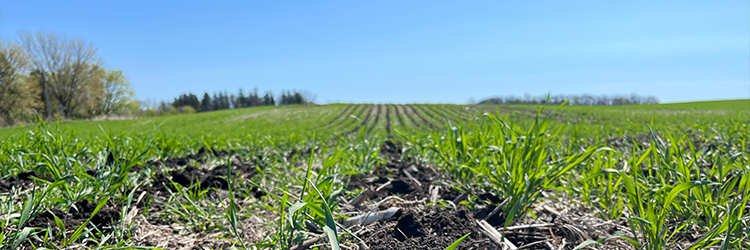Minimize disturbance
Minimizing soil disturbance is critical for preserving soil structure and promoting healthy soil biology while maintaining optimal infiltration. No-till practices reduce runoff and sediment erosion, improve water retention, and enhance soil organic matter. Disturbed soil gives undesirable plants the opportunity to move in and take root. Reduced-till methods are cost-effective, promote nutrient cycling, reinforce strong roots, and make crops more resilient to extreme weather events, such as drought and flooding.
Maximize cover
Keeping the soil covered is crucial for protecting and improving its health. When left exposed, the soil is susceptible to rain, wind, and sunlight. Utilizing cover crops, mulch, and plant residues shields the soil, reducing erosion, improving soil moisture, and protecting the organisms that support plant growth. Planting cover crops after invasive species removal can suppress unwanted invaders and revitalize the soil. Whether in a garden or a field, covering the soil helps maintain productivity, increases organic matter, promotes a healthy soil structure, and outcompetes unwanted competition.
Maximize living roots
Allowing roots to remain in the soil year-round is critical for maintaining soil health. Roots act as a food source for beneficial microbes that live in the soil and, in turn, improve soil structure and increase organic matter, which helps the soil retain moisture and nutrients. Cover crops, perennials, and diverse planting rotations nourish the microorganisms outside the primary growing season, leading to stronger plants and more resilient ecosystems. Maximize living roots in your yard by creating habitat for pollinators!
Maximize biodiversity
Biodiversity refers to the variety of plants, animals, and other organisms that comprise an ecosystem. In terms of soil health, more diversity in crop rotations leads to healthier, more balanced systems that increase function, reduce input costs, and increase profitability. Implementing cover crops, rotating plantings, and incorporating flowers and native plants can attract beneficial insects, thereby preventing disease and pest problems. Biodiversity is the key to creating a fully functioning soil food web, which enables nutrient, energy, and water cycling to operate at their highest potential.
 Back to tab navigation.
End of tab content.
Back to tab navigation.
End of tab content.
